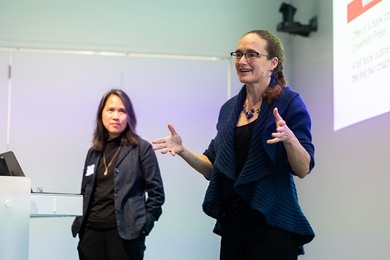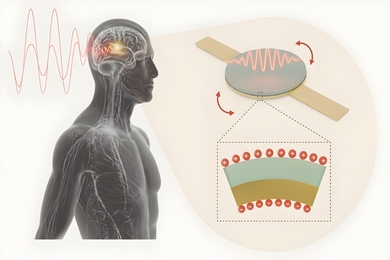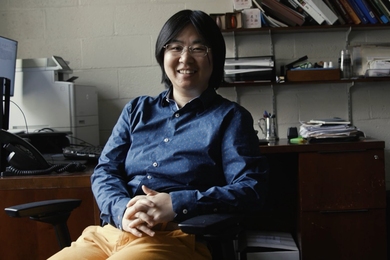Seven MIT women faculty are among the 60 top scientists cited in the November issues of Popular Science and Discover magazine.
Professors Angela M. Belcher and Linda G. Griffith are featured in Popular Science. They are among the "PopSci Brilliant 10," a list of "scientists who are shaking up their fields and whose work will touch your life," according to the magazine. "The men and women in our first annual list are not famous yet, but they are ground-breaking, risk-taking, maniacally committed researchers."
Belcher is an associate professor in the Department of Materials Science and Engineering and the Biological Engineering Division. Griffith is a professor in the Biological Engineering Division and the Department of Chemical Engineering.
Another five MIT faculty members appear in Discover magazine's story on the 50 most important women in science. The magazine reports that "to read their stories is to understand how important it is that the barriers facing women in science be broken down as quickly and entirely as possible. If just one of these women had gotten fed up and quit--as many do--the history of science would have been impoverished."
The MIT faculty cited are Institute Professor Mildred S. Dresselhaus, whose research is in electrical engineering and computer science and in physics; Susan Lindquist, a professor in the Department of Biology and director of the Whitehead Institute for Biomedical Research; Barbara H. Liskov, the Ford Professor of Engineering and associate head of computer science and engineering in the Department of Electrical Engineering and Computer Science; Institute Professor Sheila E. Widnall of aeronautics and astronautics and the Engineering Systems Division; and Maria Zuber, the Earle Griswold Professor of Geophysics and Planetary Science in the Department of Earth, Atmospheric and Planetary Sciences.
ANGELA M. BELCHER (Popular Science)
"Rather than making machines that mimic animals, Belcher is coaxing living creatures to produce machines," Popular Science wrote. A "pioneer in this field, [she] has engineered viruses that can grow semiconductor materials, microscopic biosensors and liquid-crystal structures for computer screens or DNA-storage devices. It takes her just three weeks to 'evolve' a virus to produce a new substance on its surface."
What makes Belcher tick? According to the magazine, which ran an accompanying Q&A with that title, her favorite food is tex-mex nachos, her favorite writer is Shakespeare and her favorite animal is her dog Squeaker. What is she like when totally immersed in her work? "Intense and quiet. People could be evacuated around me and I wouldn't notice," she told Popular Science.
LINDA GRIFFITH (Popular Science)
"Most recently, Griffith made a miniature 'liver' on a silicon chip and is working with the government to develop it into a practical tool that, placed in soldiers' uniforms, would detect chemical and biological warfare agents. Griffith's work is at the crossroads of biology and engineering; the discipline she's helping forge envisions the body as an ever-improvable product," Popular Science wrote.
The magazine describes her as "a kinetically charged blonde from Georgia who talkssofastshesoundslikethis." Her favorite musician is Tom Waits, her favorite web site is weather.com and her favorite movie is "anything by Alfred Hitchcock." What is she like when totally immersed in her work? "Single-minded."
"I'm glad for any opportunity to get the message out to a broad audience that folks at MIT are working on creative solutions to eliminate the use of animals in development of drugs and other applications," Griffith said this week.
MILDRED S. DRESSELHAUS (Discover)
"Before her fourth child hit kindergarten, Dresselhaus deciphered the electronic structure of graphite, the lowest-energy solid-state form of carbon," Discover reported. "The daunting problem had long scared off other researchers, which is why she chose it: 'I wanted to be able to move more slowly, without so much competition.' Her other ground-breaking studies contributed to the discovery of buckyballs and carbon nanotubes."
What does it mean to be included in the Discover feature? "I am, of course, very happy to have people appreciate my doing what I love to do, which is exploring the unknown," Dresselhaus said in an interview. "I'm really pleased by the stellar performance of my colleagues at MIT for getting 10 percent of the overall citations in Discover magazine."
SUSAN LINDQUIST (Discover)
"There is much more richness to biology and the biology of proteins than we'd ever previously believed," Lindquist told Discover, which called her "one of the world's leading experts in prions, the misfolded proteins that cause mad cow disease." Lindquist's work "has shown that, like DNA, proteins can carry inherited traits through generations."
BARBARA H. LISKOV (Discover)
"Liskov's work in data abstraction in the 1970s paved the way for writing far more complex and subtle computer programs," Discover said. "She was also a key figure in the development of applications that run on distributed collections of computers connected by a network. Now she concentrates on byzantine fault-recovery programs, which protect sensitive data from malfunction and malicious attacks."
"It's extremely exciting to be cited by Discover magazine as a top-notch scientist/engineer. I think a great deal of the credit for what I've accomplished must go to MIT because of the wonderful students and colleagues and encouragement I've found here," Liskov said in an interview.
SHEILA E. WIDNALL (Discover)
"Blow a smoke ring and notice that in calm air, it undulates gently. Those wiggles are termed the 'Widnall instability,' and, by discovering them, this scientist rewrote the book on fluid dynamics," reported Discover, which noted that Widnall is a former Secretary of the Air Force.
Commenting on the Discover feature, she said, "I'm delighted to see so many MIT women cited. I hope this visibility gives encouragement to young women and their parents about the opportunities for careers in science and engineering for women. It also recognizes MIT's success in bringing excellent women onto its faculty."
MARIA ZUBER (Discover)
"Using laser ranging, gravity measurements and data from spacecraft, Zuber maps surface features and probes the interior of Mars, Venus, Jupiter's moons and our own moon," the magazine wrote. Her goal, she told Discover, is to "figure out the processes that acted on a particular body in the past in order to make its surface the way it is now."
"Space exploration is inherently a collaborative venture and I view the [Discover] citation as recognition of the importance of the endeavor and of the collective achievement of my collaborators and students," she said in an interview.
On its website describing the top 50 women in science, Discover includes a link to MIT's report "A Study on the Status of Women Faculty in Science at MIT." The full Discover story is available in newsstand issues of the magazine.












